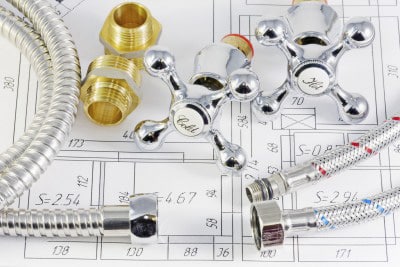
As we talked about last time, old pipes can be a big problem in older homes. The presence of do-it-yourself repairs or plumbing installed before the 1990s deserves extra attention. Here is some more information on what to be wary of.
Water Supply Plumbing
Today pipes for drinking water are typically made of copper or PEX (a high-quality type of plastic). The three most common supply pipe problems in old construction involve galvanized polybutylene and lead lines.
- Galvanized iron and galvanized steel lines are protected by a thin coating of plated zinc. Commonly used up until the 1970s they’re normally quite durable, but any damage to that thin zinc layer leaves them highly susceptible to corrosion.
- Polybutylene plumbing was essentially a disaster, being damaged from the inside out from common oxidants such as chlorine and even oxygen dissolved in the water.
- Lead pipes are still around, and slight changes in water chemistry can suddenly trigger significant health hazards. Further, copper plumbing used to involve lead in their joints. So inspection and frequent water quality testing are critical.
Sediment and mineral scale can be problems in any type of pipe, resulting in low water pressure. But galvanized pipes are particularly prone to these sorts of problems.
Drain and Sewer Lines
Decades of grease, soap scum and mineral scale can give drain lines their sort of arteriosclerosis. That means slow-running drains and frequent clogs until those lines are thoroughly cleaned or replaced.
The quality of various types of sewer pipes used over the decades ranging from last-a-century to what-were-they-thinking. Cast iron and clay lines are durable but prone to root invasions from trees and shrubbery. Installation mistakes, as well as the ravages of time, can also lead to problems.
- Shifting soil can separate or offset joints in clay and cast iron lines, leading to sewage leaks.
- Settling soil can cause just about any type of sewer line pipe to the belly. That is to say so that grease and debris collect in the low section causing clogs and backups.
Repair or Re-Pipe?
Occasional problems are to be expected. But if you’ve needed several leak repairs over the years then it’s time to consider replacing your plumbing. That’s no small expense, so unless your system includes polybutylene or lead you’ll need to carefully think through your decision.
The good news is that most homes built before the 1960s have probably already been re-piped. The bad news is that it takes a detailed inspection by a licensed plumber to determine the condition of water supply, drain, sewer, and gas lines. And a full inspection involves taking a look inside pipes.
If the pipes are fairly new it’s often better to simply repair the pipe wherever the problem happens to be. The same goes if only one or two short sections of a supply or sewer pipe are in poor condition.
But if the plumbing is showing its age and is poor condition overall, or was improperly installed, then the lowest cost option, in the long run, is to update your plumbing with a re-pipe.
Other indications that re-piping is in order are low water pressure (suggesting a pressure drop due to corrosion, scale, and sediment in the pipes) as well as rust-colored water (an indication of corrosion that may not be visible from the outside).
If the plumbing is more than 50 years old then it’s time to replace it.
That roughly coincides with the average lifetime of most types of pipe
as well as when galvanized and cast iron was phased out.





